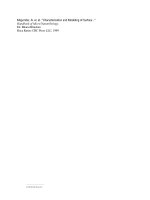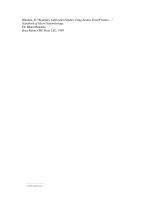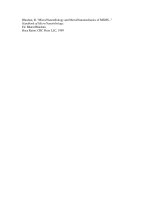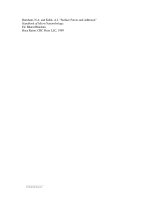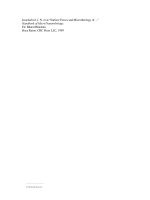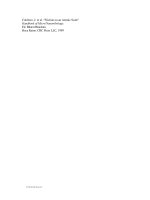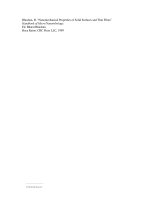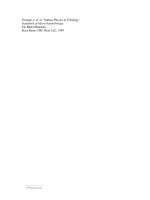Handbook of machining and metalworking calculations
Bạn đang xem bản rút gọn của tài liệu. Xem và tải ngay bản đầy đủ của tài liệu tại đây (5.58 MB, 379 trang )
HANDBOOK OF
MACHINING
AND
METALWORKING
CALCULATIONS
This page intentionally left blank.
HANDBOOK OF
MACHINING
AND
METALWORKING
CALCULATIONS
Ronald A. Walsh
McGRAW-HILL
New York San Francisco Washington, D.C. Auckland Bogotá
Caracas Lisbon London Madrid Mexico City Milan
Montreal New Delhi San Juan Singapore
Sydney Tokyo Toronto
Copyright © 2001 by The McGraw-Hill Companies, Inc. All rights reserved. Manufactured in the United States of
America. Except as permitted under the United States Copyright Act of 1976, no part of this publication may be repro-
duced or distributed in any form or by any means, or stored in a database or retrieval system, without the prior writ-
ten permission of the publisher.
0-07-141485-1
The material in this eBook also appears in the print version of this title: 0-07-136066-2.
All trademarks are trademarks of their respective owners. Rather than put a trademark symbol after every occur-
rence of a trademarked name, we use names in an editorial fashion only, and to the benefit of the trademark owner,
with no intention of infringement of the trademark. Where such designations appear in this book, they have been
printed with initial caps.
McGraw-Hill eBooks are available at special quantity discounts to use as premiums and sales promotions, or for
use in corporate training programs. For more information, please contact George Hoare, Special Sales, at
or (212) 904-4069.
TERMS OF USE
This is a copyrighted work and The McGraw-Hill Companies, Inc. (“McGraw-Hill”) and its licensors reserve all
rights in and to the work. Use of this work is subject to these terms. Except as permitted under the Copyright Act
of 1976 and the right to store and retrieve one copy of the work, you may not decompile, disassemble, reverse engi-
neer, reproduce, modify, create derivative works based upon, transmit, distribute, disseminate, sell, publish or sub-
license the work or any part of it without McGraw-Hill’s prior consent. You may use the work for your own non-
commercial and personal use; any other use of the work is strictly prohibited. Your right to use the work may be
terminated if you fail to comply with these terms.
THE WORK IS PROVIDED “AS IS”. McGRAW-HILL AND ITS LICENSORS MAKE NO GUARANTEES OR
WARRANTIES AS TO THE ACCURACY, ADEQUACY OR COMPLETENESS OF OR RESULTS TO BE
OBTAINED FROM USING THE WORK, INCLUDING ANY INFORMATION THAT CAN BE ACCESSED
THROUGH THE WORK VIA HYPERLINK OR OTHERWISE, AND EXPRESSLY DISCLAIM ANY WAR-
RANTY, EXPRESS OR IMPLIED, INCLUDING BUT NOT LIMITED TO IMPLIED WARRANTIES OF MER-
CHANTABILITY OR FITNESS FOR A PARTICULAR PURPOSE. McGraw-Hill and its licensors do not warrant
or guarantee that the functions contained in the work will meet your requirements or that its operation will be unin-
terrupted or error free. Neither McGraw-Hill nor its licensors shall be liable to you or anyone else for any inaccu-
racy, error or omission, regardless of cause, in the work or for any damages resulting therefrom. McGraw-Hill has
no responsibility for the content of any information accessed through the work. Under no circumstances shall
McGraw-Hill and/or its licensors be liable for any indirect, incidental, special, punitive, consequential or similar
damages that result from the use of or inability to use the work, even if any of them has been advised of the possi-
bility of such damages. This limitation of liability shall apply to any claim or cause whatsoever whether such claim
or cause arises in contract, tort or otherwise.
DOI: 10.1036/0071414851
Want to learn more?
We hope you enjoy this McGraw-Hill eBook!
If you d like more information about this
book, its author, or related books and websites,
please click her
e.
CONTENTS
Preface
ix
Chapter 1. Mathematics for Machinists and Metalworkers 1.1
1.1 Geometric Principles—Plane Geometry / 1.1
1.2 Basic Algebra / 1.7
1.2.1 Algebraic Procedures / 1.7
1.2.2 Transposing Equations (Simple and Complex) / 1.9
1.3 Plane Trigonometry / 1.11
1.3.1 Trigonometric Laws / 1.13
1.3.2 Sample Problems Using Trigonometry / 1.21
1.4 Modern Pocket Calculator Procedures / 1.28
1.4.1 Types of Calculators / 1.28
1.4.2 Modern Calculator Techniques / 1.29
1.4.3 Pocket Calculator Bracketing Procedures / 1.31
1.5 Angle Conversions—Degrees and Radians / 1.32
1.6 Powers-of-Ten Notation / 1.34
1.7 Percentage Calculations / 1.35
1.8 Temperature Systems and Conversions / 1.36
1.9 Decimal Equivalents and Millimeters / 1.37
1.10 Small Weight Equivalents: U.S. Customary (Grains and Ounces) Versus Metric
(Grams) / 1.38
1.11 Mathematical Signs and Symbols / 1.39
Chapter 2. Mensuration of Plane and Solid Figures 2.1
2.1 Mensuration / 2.1
2.2 Properties of the Circle / 2.10
Chapter 3. Layout Procedures for Geometric Figures 3.1
3.1 Geometric Constructions / 3.1
Chapter 4. Measurement and Calculation Procedures for Machinists 4.1
4.1 Sine Bar and Sine Plate Calculations / 4.1
4.2 Solutions to Problems in Machining and Metalworking / 4.6
4.3 Calculations for Specific Machining Problems (Tool Advance,Tapers, Notches and
Plugs, Diameters, Radii, and Dovetails) / 4.15
4.4 Finding Complex Angles for Machined Surfaces / 4.54
v
Copyright 2001 by The McGraw-Hill Companies, Inc. Click Here for Terms of Use.
For more information a bout this book, click here.
Chapter 5. Formulas and Calculations for Machining Operations 5.1
5.1 Turning Operations / 5.1
5.2 Threading and Thread Systems / 5.12
5.3 Milling / 5.22
5.4 Drilling and Spade Drilling / 5.38
5.5 Reaming / 5.61
5.6 Broaching / 5.63
5.7 Vertical Boring and Jig Boring / 5.66
5.8 Bolt Circles (BCs) and Hole Coordinate Calculations / 5.67
Chapter 6. Formulas for Sheet Metal Layout and Fabrication 6.1
6.1 Sheet Metal Flat-Pattern Development and Bending / 6.8
6.2 Sheet Metal Developments, Transitions, and Angled Corner Flange Notching / 6.14
6.3 Punching and Blanking Pressures and Loads / 6.32
6.4 Shear Strengths of Various Materials / 6.32
6.5 Tooling Requirements for Sheet Metal Parts—Limitations / 6.36
Chapter 7. Gear and Sprocket Calculations 7.1
7.1 Involute Function Calculations / 7.1
7.2 Gearing Formulas—Spur, Helical, Miter/Bevel, and Worm Gears / 7.4
7.3 Sprockets—Geometry and Dimensioning / 7.15
Chapter 8. Ratchets and Cam Geometry 8.1
8.1 Ratchets and Ratchet Gearing / 8.1
8.2 Methods for Laying Out Ratchet Gear Systems / 8.3
8.2.1 External-Tooth Ratchet Wheels / 8.3
8.2.2 Internal-Tooth Ratchet Wheels / 8.4
8.2.3 Calculating the Pitch and Face of Ratchet-Wheel Teeth / 8.5
8.3 Cam Layout and Calculations / 8.6
Chapter 9. Bolts, Screws, and Thread Calculations 9.1
9.1 Pullout Calculations and Bolt Clamp Loads / 9.1
9.2 Measuring and Calculating Pitch Diameters of Threads / 9.5
9.3 Thread Data (UN and Metric) and Torque Requirements (Grades 2, 5, and 8 U.S.
Standard 60° V)/9.13
Chapter 10. Spring Calculations—Die and Standard Types 10.1
10.1 Helical Compression Spring Calculations / 10.5
10.1.1 Round Wire / 10.5
10.1.2 Square Wire / 10.6
10.1.3 Rectangular Wire / 10.6
10.1.4 Solid Height of Compression Springs / 10.6
10.2 Helical Extension Springs (Close Wound) / 10.8
vi CONTENTS
10.3 Spring Energy Content of Compression and Extension Springs / 10.8
10.4 Torsion Springs / 10.11
10.4.1 Round Wire / 10.11
10.4.2 Square Wire / 10.12
10.4.3 Rectangular Wire / 10.13
10.4.4 Symbols, Diameter Reduction, and Energy Content / 10.13
10.5 Flat Springs / 10.14
10.6 Spring Materials and Properties / 10.16
10.7 Elastomer Springs / 10.22
10.8 Bending and Torsional Stresses in Ends of Extension Springs / 10.23
10.9 Specifying Springs, Spring Drawings, and Typical Problems and Solutions / 10.24
Chapter 11. Mechanisms, Linkage Geometry, and Calculations 11.1
11.1 Mathematics of the External Geneva Mechanism / 11.1
11.2 Mathematics of the Internal Geneva Mechanism / 11.3
11.3 Standard Mechanisms / 11.5
11.4 Clamping Mechanisms and Calculation Procedures / 11.9
11.5 Linkages—Simple and Complex / 11.17
Chapter 12. Classes of Fit for Machined Parts—Calculations 12.1
12.1 Calculating Basic Fit Classes (Practical Method) / 12.1
12.2 U.S. Customary and Metric (ISO) Fit Classes and Calculations / 12.5
12.3 Calculating Pressures, Stresses, and Forces Due to Interference Fits, Force Fits, and
Shrink Fits / 12.9
Index I.1
CONTENTS vii
This page intentionally left blank.
PREFACE
This handbook contains most of the basic and advanced calculation procedures
required for machining and metalworking applications. These calculation proce-
dures should be performed on a modern pocket calculator in order to save time and
reduce or eliminate errors while improving accuracy. Correct bracketing procedures
are required when entering equations into the pocket calculator, and it is for this
reason that I recommend the selection of a calculator that shows all entered data on
the calculator display and that can be scrolled.That type of calculator will allow you
to scroll or review the entered equation and check for proper bracketing sequences,
prior to pressing “ENTER” or =. If the bracketing sequences of an entered equation
are incorrect, the calculator will indicate “Syntax error,”or give an incorrect solution
to the problem. Examples of proper bracketing for entering equations in the pocket
calculator are shown in Chap. 1 and in Chap. 11, where the complex four-bar linkage
is analyzed and explained.
This book is written in a user-friendly format, so that the mathematical equations
and examples shown for solutions to machining and metalworking problems are not
only highly useful and relatively easy to use, but are also practical and efficient. This
book covers metalworking mathematics problems, from the simple to the highly
complex, in a manner that should be valuable to all readers.
It should be understood that these mathematical procedures are applicable for:
●
Master machinists
●
Machinists
●
Tool designers and toolmakers
●
Metalworkers in various fields
●
Mechanical designers
●
Tool engineering personnel
●
CNC machining programmers
●
The gunsmithing trade
●
Students in technical teaching facilities
R.A. Walsh
ix
Copyright 2001 by The McGraw-Hill Companies, Inc. Click Here for Terms of Use.
This page intentionally left blank.
HANDBOOK OF
MACHINING
AND
METALWORKING
CALCULATIONS
This page intentionally left blank.
CHAPTER 1
MATHEMATICS
FOR MACHINISTS
AND METALWORKERS
This chapter covers all the basic and special mathematical procedures of value to the
modern machinist and metalworker. Geometry and plane trigonometry are of prime
importance, as are the basic algebraic manipulations. Solutions to many basic and
complex machining and metalworking operations would be difficult or impossible
without the use of these branches of mathematics. In this chapter and other subsec-
tions of the handbook,all the basic and important aspects of these branches of math-
ematics will be covered in detail. Examples of typical machining and metalworking
problems and their solutions are presented throughout this handbook.
1.1 GEOMETRIC PRINCIPLES—
PLANE GEOMETRY
In any triangle, angle A + angle B + angle C = 180°, and angle A = 180°−(angle A +
angle B), and so on (see Fig. 1.1). If three sides of one triangle are proportional to the
corresponding sides of another triangle, the triangles are similar.Also, if a:b:c = a′:b′:c′,
then angle A = angle A′, angle B = angle B′, angle C = angle C′, and a/a′=b/b′=c/c′.
Conversely, if the angles of one triangle are equal to the respective angles of another
triangle, the triangles are similar and their sides proportional; thus if angle A = angle
A′, angle B = angle B′, and angle C = angle C′, then a:b:c = a′:b′:c′ and a/a′=b/b′=c/c′
(see Fig. 1.2).
1.1
FIGURE 1.1 Triangle.
Copyright 2001 by The McGraw-Hill Companies, Inc. Click Here for Terms of Use.
1.2 CHAPTER ONE
FIGURE 1.2 Similar triangles.
Isosceles triangle (see Fig. 1.3). If side c = side b, then angle C = angle B.
Equilateral triangle (see Fig. 1.4). If side a = side b = side c, angles A, B, and C
are equal (60°).
Right triangle (see Fig.1.5). c
2
= a
2
+ b
2
and c = (a
2
+ b
2
)
1/2
when angle C =90°.There-
fore, a = (c
2
− b
2
)
1/2
and b = (c
2
− a
2
)
1/2
.This relationship in all right-angle triangles is
called the Pythagorean theorem.
Exterior angle of a triangle (see Fig. 1.6). Angle C = angle A + angle B.
FIGURE 1.3 Isosceles
triangle.
FIGURE 1.4 Equilateral triangle.
FIGURE 1.5 Right-angled triangle. FIGURE 1.6 Exterior angle of a triangle.
Intersecting straight lines (see Fig. 1.7). Angle A = angle A′, and angle B = angle B′.
MATHEMATICS FOR MACHINISTS AND METALWORKERS 1.3
FIGURE 1.7 Intersecting straight lines.
Two parallel lines intersected by a straight line (see Fig. 1.8). Alternate interior
and exterior angles are equal: angle A = angle A′; angle B = angle B′.
Any four-sided geometric figure (see Fig. 1.9). The sum of all interior angles =
360°; angle A + angle B + angle C + angle D = 360°.
A line tangent to a point on a circle is at 90°, or normal, to a radial line drawn to the
tangent point (see Fig. 1.10).
FIGURE 1.8 Straight line intersecting two parallel lines.
FIGURE 1.9 Quadrilateral (four-sided
figure).
FIGURE 1.10 Tangent at a point on a circle.
Two circles’ common point of tangency is intersected by a line drawn between their
centers (see Fig. 1.11).
Side a = a′; angle A = angle A′ (see Fig. 1.12).
Angle A =
1
⁄2 angle B (see Fig. 1.13).
1.4 CHAPTER ONE
FIGURE 1.11 Common point of tangency.
FIGURE 1.12 Tangents and angles.
FIGURE 1.13 Half-angle (A).
Angle A = angle B = angle C. All perimeter angles of a chord are equal (see
Fig. 1.14).
Angle B =
1
⁄2 angle A (see Fig. 1.15).
a
2
= bc (see Fig. 1.16).
All perimeter angles in a circle, drawn from the diameter, are 90° (see Fig. 1.17).
Arc lengths are proportional to internal angles (see Fig. 1.18). Angle A:angle
B = a:b. Thus, if angle A = 89°, angle B = 30°, and arc a = 2.15 units of length,
arc b would be calculated as
MATHEMATICS FOR MACHINISTS AND METALWORKERS 1.5
FIGURE 1.14 Perimeter angles of a chord. FIGURE 1.15 Half-angle (B).
FIGURE 1.16 Line and circle relationship (a
2
= bc).
=
=
89b = 30 × 2.15
b =
b = 0.7247 units of length
NOTE. The angles may be given in decimal degrees or radians, consistently.
Circumferences are proportional to their respective radii (see Fig.1.19). C:C′=r:R,
and areas are proportional to the squares of the respective radii.
64.5
ᎏ
89
2.15
ᎏ
b
89
ᎏ
30
a
ᎏ
b
Angle A
ᎏ
Angle B
1.6 CHAPTER ONE
FIGURE 1.17 90° perimeter angles. FIGURE 1.18 Proportional arcs and angles.
FIGURE 1.19 Circumference and radii proportionality.
1.2 BASIC ALGEBRA
1.2.1 Algebraic Procedures
Solving a Typical Algebraic Equation. An algebraic equation is solved by substi-
tuting the numerical values assigned to the variables which are denoted by letters,
and then finding the unknown value, using algebraic procedures.
EXAMPLE
L = 2C + 1.57(D + d) + (belt-length equation)
If C = 16, D = 5.56, and d = 3.12 (the variables), solve for L (substituting the values
of the variables into the equation):
L = 2(16) + 1.57(5.56 + 3.12) +
= 32 + 1.57(8.68) +
= 32 + 13.628 +
= 32 + 13.628 + 0.093
= 45.721
Most of the equations shown in this handbook are solved in a similar manner, that
is, by substituting known values for the variables in the equations and solving for the
unknown quantity using standard algebraic and trigonometric rules and procedures.
Ratios and Proportions. If a/b = c/d, then
= ; = and =
Quadratic Equations. Any quadratic equation may be reduced to the form
ax
2
+ bx + c = 0
The two roots, x
1
and x
2
, equal
(x
1
use +; x
2
use
−)
When a,b, and c are real,if b
2
− 4ac is positive,the roots are real and unequal.If b
2
− 4ac
is zero, the roots are real and equal. If b
2
− 4ac is negative, the roots are imaginary and
unequal.
−b ±
͙
b
2
− 4a
ෆ
c
ෆ
ᎏᎏ
2a
c − d
ᎏ
c + d
a − b
ᎏ
a + b
c − d
ᎏ
d
a − b
ᎏ
b
c + d
ᎏ
d
a + b
ᎏ
b
5.954
ᎏ
64
(2.44)
2
ᎏ
64
(5.56 − 3.12)
2
ᎏᎏ
4(16)
(D − d)
2
ᎏ
4C
MATHEMATICS FOR MACHINISTS AND METALWORKERS 1.7
Radicals
a
0
= 1
(
͙
n
a
ෆ
)
n
= a
͙
n
a
n
ෆ
= a
͙
n
ab
ෆ
= n
͙
n
a
ෆ
× n
͙
n
b
ෆ
Ί
n
ᎏ
b
a
ᎏ
=
͙
n
a
ෆ
÷
͙
n
b
ෆ
͙
n
a
x
ෆ
= a
x/n
hence
͙
3
7
2
ෆ
= 7
2/3
͙
n
a
ෆ
= a
1/n
hence
͙
3
ෆ
= 3
1/2
a
−n
=
ᎏ
a
1
n
ᎏ
Factorial. 5! is termed 5 factorial and is equivalent to
5 × 4 × 3 × 2 × 1 = 120
9! = 9 × 8 × 7 × 6 × 5 × 4 × 3 × 2 × 1 = 362,880
Logarithms. The logarithm of a number N to base a is the exponent power to
which a must be raised to obtain N. Thus N = a
x
and x = log
a
N. Also log
a
1 = 0 and
log
a
a = 1.
Other relationships follow:
log
a
MN = log
a
M + log
a
N
log
a
= log
a
M − log
a
N
log
a
N
k
= k log
a
N
log
a
͙
n
N
ෆ
= log
a
N
log
b
a = b let N = a
Base 10 logarithms are referred to as common logarithms or Briggs logarithms,
after their inventor.
Base e logarithms (where e = 2.71828) are designated as natural, hyperbolic, or
Naperian logarithms, the last label referring to their inventor. The base of the natural
logarithm system is defined by the infinite series
1
ᎏ
log
a
1
ᎏ
n
M
ᎏ
N
1.8 CHAPTER ONE
e = 1 + + + + + + ⋅⋅⋅ = lim
n
→∞
1 +
n
e = 2.71828 . . .
If a and b are any two bases, then
log
a
N = (log
a
b) (log
b
N)
or log
b
N =
log
10
N ==0.43429 log
e
N
log
e
N ==2.30261 log
10
N
Simply multiply the natural log by 0.43429 (a modulus) to obtain the equivalent
common log.
Similarly, multiply the common log by 2.30261 to obtain the equivalent natural
log. (Accuracy is to four decimal places for both cases.)
1.2.2 Transposing Equations (Simple and Complex)
Transposing an Equation. We may solve for any one unknown if all other vari-
ables are known. The given equation is:
R =
An equation with five variables, shown in terms of R. Solving for G:
Gd
4
= R8ND
3
(cross-multiplied)
G = (divide both sides by d
4
)
Solving for d:
Gd
4
= 8RND
3
d
4
=
d =
Ί
4
8RND
3
ᎏ
G
8RND
3
ᎏ
G
8RND
3
ᎏ
d
4
Gd
4
ᎏ
8ND
3
log
10
N
ᎏ
0.43429
log
e
N
ᎏ
2.30261
log
a
N
ᎏ
log
a
b
1
ᎏ
n
1
ᎏ
5!
1
ᎏ
4!
1
ᎏ
3!
1
ᎏ
2!
1
ᎏ
1
MATHEMATICS FOR MACHINISTS AND METALWORKERS 1.9
Solving for D:
Gd
4
= 8RND
3
D
3
=
D =
Ί
3
Solve for N using the same transposition procedures shown before.
NOTE. When a complex equation needs to be transposed, shop personnel can con-
tact their engineering or tool engineering departments, where the MathCad pro-
gram is usually available.
Transposing Equations using MathCad (Complex Equations). The transposition
of basic algebraic equations has many uses in the solution of machining and metal-
working problems. Transposing a complex equation requires considerable skill in
mathematics. To simplify this procedure, the use of MathCad is invaluable. As an
example, a basic equation involving trigonometric functions is shown here, in its
original and transposed forms.The transpositions are done using symbolic methods,
with degrees or radians for the angular values.
Basic Equation
L = X + d ⋅
΄
tan
+ 1
΅
Transposed Equations (Angles in Degrees)
Solve, α→90 + 2 ⋅ atan
΄΅
Solved for α
Solve, X → L + d ⋅ tan
−45 +⋅α
− d Solved for X
Solve, d →
Solved for d
NOTE. The angular values are expressed in degrees.
Basic Equation
L = X + d ⋅
΄
tan
+ 1
΅
ᎏ
π
2
ᎏ
−α
ᎏ
2
(−L + X)
ᎏᎏᎏ
tan
−45 +
ᎏ
1
2
ᎏ
⋅α
− 1
1
ᎏ
2
(−L + X + d)
ᎏᎏ
d
90 −α
ᎏ
2
Gd
4
ᎏ
8RN
Gd
4
ᎏ
8RN
1.10 CHAPTER ONE
Transposed Equations (Angles in Radians)
Solve, α→ ⋅π−2 ⋅ acot
΄΅
Solved for α
Solve, X → L − d ⋅ cot
⋅π+ ⋅α
− d Solved for X
Solve, d → Solved for d
NOTE. The angular values are expressed in radians, i.e., 90 degrees =π/2 radians; 2π
radians = 360°; π radians = 180°.
1.3 PLANE TRIGONOMETRY
There are six trigonometric functions: sine, cosine, tangent, cotangent, secant, and
cosecant. The relationships of the trigonometric functions are shown in Fig. 1.20.
Trigonometric functions shown for angle A (right-angled triangle) include
sin A = a/c (sine)
cos A = b/c (cosine)
tan A = a/b (tangent)
cot A = b/a (cotangent)
sec A = c/b (secant)
csc A = c/a (cosecant)
For angle B, the functions would become (see Fig. 1.20)
sin B = b/c (sine)
cos B = a/c (cosine)
−(−L + X)
ᎏᎏᎏ
cot
ᎏ
1
4
ᎏ
⋅π+
ᎏ
1
2
ᎏ
⋅α
+ 1
1
ᎏ
2
1
ᎏ
4
(−L + X + d)
ᎏᎏ
d
3
ᎏ
2
MATHEMATICS FOR MACHINISTS AND METALWORKERS 1.11
FIGURE 1.20 Right-angled triangle.
